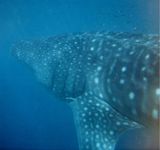ReefLink Database

Planktivorous Fish
Planktivorous Fish are fish that feed primarily on plankton.
CMap

CMap Description
The fish found on coral reefs are essential for coastal communities and extremely important in the wider world. Planktivorous fish, such as wrasses, squirrelfish, blue chromis, brown chromis, and fairy basslets, consume plankton suspended in the water column. Many planktivorous fish species are important as aquarium stock , a few species contribute to the finfish & shellfish stock, and all species are important to cultural services of coral reefs. Planktivorous fish provide a valuable link in the trophic food web since they are consumed by piscivorous fish, apex fish predators, and marine mammals and reptiles. Like all fish species, planktivorous fish are stressed and killed by competing invasive species, diseases causing microorganisms, and disturbances of the physical & chemical environment. Socio-economic drivers lead to the removal & mortality of planktivorous fish through harvesting pressures and to behavior modifications through supplemental feeding. Biological monitoring, mapping, research, and restoration is paramount to ensure the flow of services from reef fish.Citations
More than 50 citations. Click here to load.
| Citation | Year | Study Location | Study Type | Database Topics |
|---|
Management Options
| Management Option | Description | Sources | Database Topics |
|---|---|---|---|
| Fishing & Harvesting Management: Derelict Fishing Gear & Ghost Fishing | The term "ghost fishing" is used to describe the capture of marine organisms by lost or abandoned fishing gear. This is particularly a problem with gillnets, trammel nets and pots. Gear is usually lost because it becomes stuck on rough bottoms containing corals and stones, causing the buoy line to break during retrieval. Nets or pots may continue to fish for years, with captured fish and crustaceans dying and serving as attracting bait for more fish and organisms. Ghost fishing may therefore represent a serious problem in many areas, causing hidden fishing mortality over a long period of time. This management option co-insides with (#63) Respond to Natural Resource Injuries form Derelict Vessels. | Cochrane, K.L., editor. 2002. A Fishery Manager's Guidebook. Management Measures and their application. Fisheries Technical Paper 424, FAO, Rome. Seas At Risk. 2009. Moving Towards Low Impact Fisheries In Europe Policy Hurdles & Actions. |
Accidental & Illegal Harvest; Apex Fish Predators; Aquaculture; Arthropods; Artificial Habitat; Artisanal Fishing; Biological Addition; Biological Harvest; Commercial Fisheries; Corallivorous Fish; Discharges; Finfish & Shellfish Stock; Fish; Fishing & Harvesting Management; Fishing Sector; Invertivorous Fish; Large Herbivorous Fish; Littering; Lobster, Crab, & Shrimp; Marine Debris; Piscivorous Fish; Planktivorous Fish; Provisioning Services; Recreational Fishing; Trawling & Fishing Gear Damage |
| Monitor & Research: Fisheries Sampling | Improved fisheries sampling programs require improving the spatial resolution of commercial and recreation fisheries-dependent and fisheries-independent sampling programs to provide statistics on catch and effort. Improved sampling can be achieved through evaluating and enhancing census programs by using smaller sampling areas. Also, fishery pre-recruitment monitoring efforts should be continued for long-term prediction of fishery stocks. Last, investigating life histories of fishery species needs to be conducted because it is currently a gap. | NOAA Marine Sanctuary Program. 2007. Florida Keys National Marine Sanctuary revised management plan. National Ocean Service, Key West, FL. |
Apex Fish Predators; Biological Harvest; Biological Monitoring & Restoration; Biological Monitoring, Mapping, & Scientific Research; Corallivorous Fish; Decision Support; Ecosystem Monitoring & Restoration; Finfish & Shellfish Stock; Fish; Fishing & Harvesting Management; Fishing Sector; Invertivorous Fish; Large Herbivorous Fish; Piscivorous Fish; Planktivorous Fish; Provisioning Services; Reef Inhabitants; Reef Life; Security & Public Administration Policies; Small Herbivorous Fish |
| Resource Use Management: Seasonal Fisheries and Harvesting | Finfish and shellfish stocks may be more or less susceptible to fishing pressures during certain times of the year. This may be due to seasonality of recruitment and/or changes in food/predation pressures. If fishing restrictions may be more successful if this seasonality is taken into consideration and fishing pressure adjusted accordingly. | Accidental & Illegal Harvest; Apex Fish Predators; Artisanal Fishing; Biochemical & Genetic Resources; Biological Harvest; Bivalves; Commercial Fisheries; Corallivorous Fish; Decision Support; Echinoderms; Finfish & Shellfish Stock; Finfish Harvest; Fish; Fisheries & Hunting Policies; Fishing & Harvesting Management; Fishing Sector; Food & Energy Policies; Invertebrate Harvest; Invertivorous Fish; Large Herbivorous Fish; Live Collection; Lobster, Crab, & Shrimp; Marine Products; Molluscs; Octopus & Squid; Permitting & Zoning; Piscivorous Fish; Planktivorous Fish; Provisioning Services; Recreational Fishing; Small Herbivorous Fish; Snails & Conch; Sponges; Tourism & Recreation Policies | |
| Resource Use Management: Fisheries Catch Quotas | Quotas designate the Total Allowable Catch (TAC) allocated to an operating unit such as a country, a vessel, a company or an individual fisherman (individual quota) depending on the system of allocation. Quotas may or may not be transferable, inheritable, and tradable. While generally used to allocate total allowable catch, quotas could be used also to allocate fishing effort or biomass. | Seas At Risk. 2009. Moving Towards Low Impact Fisheries In Europe Policy Hurdles & Actions. |
Accidental & Illegal Harvest; Anchoring & Vessel Grounding; Apex Fish Predators; Artisanal Fishing; Biological Harvest; Bivalves; Boat Movement; Boating Activities; Commercial Fisheries; Commercial Fishing Boats; Finfish & Shellfish Stock; Finfish Harvest; Fish; Fisheries & Hunting Policies; Fishing & Harvesting Management; Fishing Sector; Food & Raw Materials; Invertebrate Harvest; Invertivorous Fish; Large Herbivorous Fish; Live Collection; Lobster, Crab, & Shrimp; Marine Products; Molluscs; Octopus & Squid; Piscivorous Fish; Planktivorous Fish; Provisioning Services; Recreational Fishing; Snails & Conch; Trawling & Fishing Gear Damage |
Laws
| Legal Citation | Purpose of Law | Management Organization | Database Topics |
|---|
